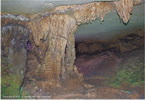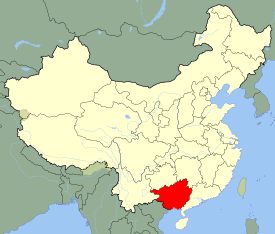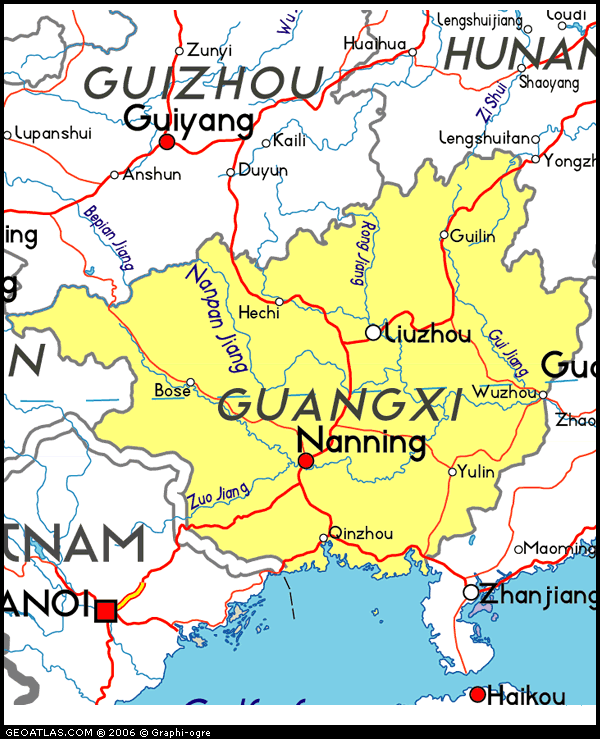|
SANJIANG area |
|
|
 |
Sanjiang City |
|
GPS: |
25.78319,
109.60767 |
|
The region of Sanjiang and
Chengyang villages, north of
Guangxi, offers an incredible
diversity of encounters with the
Dong people through small
villages containing many
traditional, religious and
historical buildings, which have
been feeding since always
Chinese legends. |
|
|
|
|
|
|
 |
Chenyang 程阳 |
|
GPS: |
25.89708,
109.64388 |
Chengyang is a district
consisting of eight villages,
located 4–5 hours from Guilin,
in the Sanjiang Dong Autonomous
County of Guangxi province of
China.
It is known for its
"Folk Custom Centre" and the
Chengyang Bridge, a covered
bridge known locally as a "wind
and rain bridge" due to the
protection it offers from the
weather. |
|
|
| |
|
|
|
|
|
|
|
Chenyang village 程阳 |
|
GPS: |
25.89708,
109.64388 |
|
Chengyang Dong Village, bordered
by the Lingxi River, is home to
one of Dong’s most impressive
wind and rain bridges (Yongji
Bridge), now a historic
monument. According to Chinese
myth, it was built in the early
twentieth century, in honor of a
Dragon who would have saved a
woman fallen into the river by
wanting to cross. The Dong
architecture of the village is
remarkable.. |
 |
|
|
|
|
|
|
|
National day event |
|
GPS: |
na |
|
na |
 |
|
|
|
|
|
|
|
GUILIN area |
|
|
 |
Guilin 桂林市 |
|
GPS: |
25.25528,
110.28054 |
|
Located in the northeast of
Guangxi Zhuang Autonomous Region
in south China, Guilin is
considered to be the pearl of
China's thriving tourist
industry on account of the
natural beauty and historic
treasures. Covering an area of
about 27,800 square kilometers
(10,734 square miles), the city
is rather compact when compared
with other major travel
destinations in the country. |
|
|
| |
|
|
|
|
|
|
|
Guilin
City 桂林市 |
|
GPS: |
25.25528,
110.28054 |
|
Guilin is a city in southern
China known for its dramatic
landscape of limestone karst
hills. At its center are 2
lakes, Shanhu (Cedar) and Ronghu
(Banyan), remaining from a
medieval-era moat that once
surrounded the city. On Shanhu
Lake’s shore, twin pagodas, the
Sun and Moon, light up the sky
at night. |
 |
|
|
|
|
|
|
|
Reed Flute Cave 芦笛岩 |
|
GPS: |
25.30513,
110.2727 |
|
The Reed Flute Cave, also known
as "the Palace of Natural Arts”
is a landmark and tourist
attraction in Guilin, Guangxi,
China. It is a natural limestone
cave with multicolored lighting
and has been one of Guilin's
most interesting attractions for
over 1200 years. It is over 180
million years old. |
 |
|
|
|
|
|
|
 |
Li River 漓江 |
|
GPS: |
25.14935,
110.43283 |
|
Board a regular baot and take it
down the Li River from Guilin to
Yangshuo. This is one of the
most popular ways to arrive in
Yangshuo. The stretch of river
between Guilin and Yangshuo is
almost completely sheltered in
by mountains on both sides.
Unfortunately, the boats can
only be boarded in Guilin and
not Yangshuo. |
 |
|
| |
|
|
LONGSHENG area |
|
|
 |
Longsheng 龙胜 |
|
GPS: |
25.79986,
110.00906 |
|
Longsheng County is famous for
its beautiful rice terraced
fields and ethnic villages in
mountainous areas. The
well-known Longji Rice Terraced
Fields were built through many
generations’ hard work ever
since the Yuan Dynasty
(1271-1368). |

 |
|
| |
|
|
|
|
|
|
|
Longi terrasses 龙脊梯田 |
|
GPS: |
25.75846,
110.12326 |
Also known as the “LongSheng,”
the LongJi Rice Terraces were
built by farmers almost 650
years ago. This vast area of
rolling mountains are completely
carved out into terraces that
are divided in layers of water
and rice shoots. Many say it’s
the most beautiful sight in
Yangshuo.
The farming
villages in this area have
retained much traditional
culture and are welcoming
foreigners. |
 |
|
|
|
|
|
|
|
Huangluo / Ping'An Yaos Village
黄洛 |
|
GPS: |
25.76084,
110.12877 |
Huangluo Yao Village is the only
village of Yao minority in
Longji scenic area. All the
villagers, totaling just over
400, are Yao ethnic minority.
One of the local traditions is
to keep long hair.
In the
past, local women's long hair
was not supposed to be seen by
others, even by their husband or
children. Therefore, Yao women
used a long cloth to twist and
hide their hair into a knot. |
 |
|
|
|
|
|
|
|
YANGSHUO area |
|
|
 |
Fuli
village 福利镇 |
|
GPS: |
24.78689,
110.55836 |
|
Fuli town, located about eight
kilometers east of Yangshuo
County, is a quiet old town with
a history of 800 years, and
particularly known as the
artistic town of the area with
its typical colorful fans and
scroll paintings. |
|
|
|
|
 |
Xiping village
兴坪镇 |
|
GPS: |
24.91712,
110.52935 |
|
Xingping is the major starting
point for the most scenic
stretch of the Li River, which
runs north and upstream to the
small town of Yangdi. The
scenery around Xingping is
magnificent and you can take a
walk out of town. |
|
|
| |
|
 |
Yangshuo 阳朔县 |
|
GPS: |
24.77848,
110.49659 |
|
Yangshuo is known for its
dramatic karst mountain
landscape and outdoor
recreation. The town is set amid
pinnacles like Bilian Feng
(Green Lotus Peak), which has a
hiking trail to the top. Tour
boats offer cruises on the Li
River past picturesque
countryside from the town of
Guilin to the north. |
 |
|
| |
|
|
|
|
|
|
|
Buddha cave |
|
GPS: |
na |
|
Also called the Buddha Water
Cave, it has superlative karst
landforms that cover an area of
5Kms. The Cave contains a mud
bath area, underground hot
springs area, and the waterless
scenic area. You will also get
to see the most peculiar
stalactites and stalagmites
inside the Cave. |
 |
|
|
|
|
|
|
|
Dragon cave |
|
GPS: |
na |
|
The cave is easily explored for
all travelers with a concrete
path throughout. The stalagmites
and stalactites are illuminated
with colored lighting giving it
an other-worldly feeling that
children will enjoy. There are
several ponds that are pristine
and reflect the light like a
mirror. |
 |
|
|
|
|
|
|
|
Yangshuo village 阳朔县 |
|
GPS: |
24.77848,
110.49659 |
|
Yangshuo is a small town nestled
in the center of mountains that
encircle it like the petals of a
lotus. The small town with
unique charm is crossed by the
Li River. The Yangshuo market is
particularly interesting and
representative of Chinese
craftsmanship and art. Moreover,
the famous district of West
Street offers a very pleasant
and cheerful western atmosphere. |

 |
|
|
|
|
|
|
|
Yangshuo surrounding - Moon Hill
月亮山 |
|
GPS: |
24.72184,
110.47695 |
Moon Hill is a hill with a
natural arch through it a few
kilometers outside Yangshuo. It
is so named for a wide,
semicircular hole through the
hill
It takes roughly 20
minutes to climb up to the arch
(about 800 steps), or
considerably longer for those
who wish to reach the summit.
Visitors must pay an entrance
fee in order to climb the hill. |

 |
|
|
|
|
|
|
|
Cormorant fishing
鸕鶿捕魚 |
|
GPS: |
na |
Cormorant fishing is a
traditional fishing method in
which fishermen use trained
cormorants to fish in rivers.
Historically, cormorant fishing
has taken place in Japan and
China. This technique has also
been used in other countries but
is currently under threat in
China.
To control the birds,
the fishermen tie a snare near
the base of the bird's throat.
This prevents the birds from
swallowing larger fish, which
are held in their throat. |
 |
|
|
|









